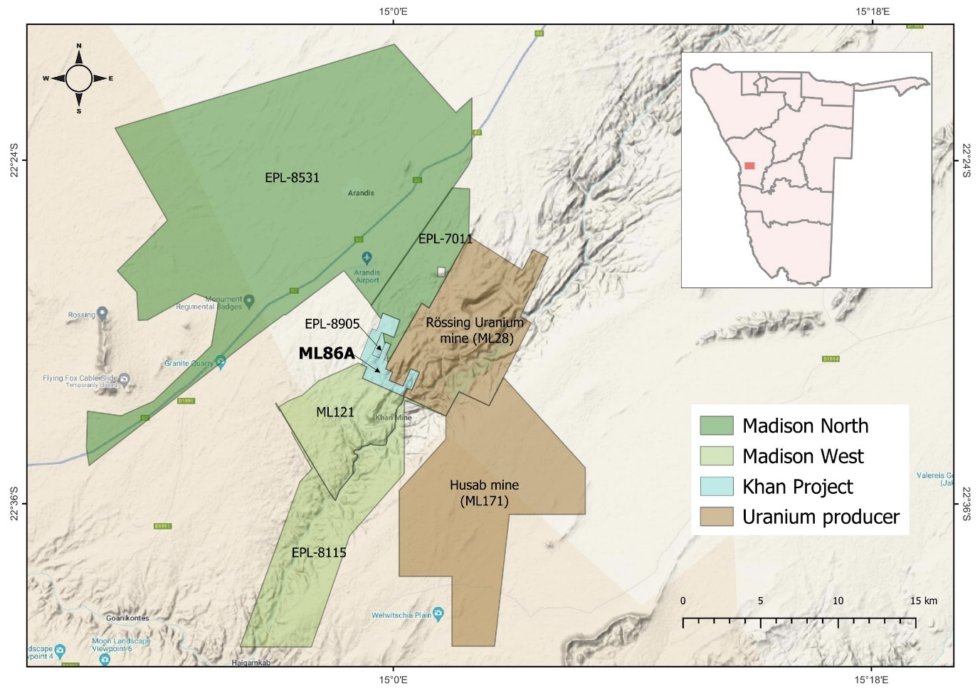Madison Metals Inc has provided a comprehensive update on its recent exploration activities at the Khan Project in Namibia’s Erongo uranium province.
 Plan map showing the location of ML86A, other Madison properties and current producing uranium mines in Namibia’s Erongo uranium province. Image Credit: Madison Metals Inc.
Plan map showing the location of ML86A, other Madison properties and current producing uranium mines in Namibia’s Erongo uranium province. Image Credit: Madison Metals Inc.
The project comprises Mining Licence 86A (ML86A) and Exclusive Prospecting Licence 8905 (EPL-8905), situated immediately southwest of the operational Rössing Uranium Mine.
Historically, ML86A has not undergone detailed uranium exploration due to prior copper mining activities within the license.
The recent exploration efforts by Madison Metals focused on validating previously untested airborne radiometric anomalies and gaining insights into the geological setting, with a particular emphasis on determining the continuity of mineralized alaskites.
ML86A is characterized by geology favorable for Rössing-type deposits in Central Namib, where uranium-mineralized alaskites intrude units of the Damara Supergroup.
The analysis of the airborne survey revealed several anomalies adjacent to the Khan mine workings and adits on EPL-8905. Subsequent fieldwork confirmed that these anomalies were primarily non-fertile Sheeted Leucogranite (SLG), known as C type.
However, additional anomalies prompted Madison's exploration team to shift their focus to the southeast, specifically on Anomaly 5, where uranium-bearing D type SLG have been identified.
This update suggests that Madison Metals is actively assessing and exploring the uranium potential within its licensed areas, leveraging historical data and recent survey findings.
The focus on specific anomalies with indications of uranium mineralization underscores the strategic approach taken by the company in its exploration activities in the highly prospective Erongo uranium province.
The Khan Project is quickly becoming an extremely valuable asset to Madison, having huge potential for making new high-grade uranium discoveries sitting right next to two operating uranium mines.
Duane Parnham, Executive Chairman and CEO, Madison Metals Inc
Parnham added, “Madison has deployed field personnel to perform channel sampling and chemical analysis across favorable high-grade uranium rocks and expand the ground survey to other targets at ML86A in advance of a planned 2024 drilling program at Anomaly 5.”
Anomaly 5
Anomaly 5 represents a notable regional anomaly characterized by elevated uranium and uranium/thorium (Th) levels. It is situated within a north-northeast-trending fold closure, approximately 8 km southwest of the Rössing Mine and 7 km southwest of the Husab Mine pits.
Madison conducted a comprehensive ground radiometric and geological mapping survey over Anomaly 5, initially employing an 80-m line spacing and a 10-m station spacing. Subsequently, a survey with a 40-m line spacing was conducted to assess the surface continuity of the target host units.
The ground survey confirmed the presence of Damaran units from the Khan, Rössing, and Chuos formations, intruded by various post-tectonic intrusives, including radiometric anomalous alaskites. These alaskites manifest as veins, dyke-like, or anastomosing intrusions, predominantly within the Khan Formation and occasionally in the Rössing Formation.
With a surface thickness of up to 7 m, the alaskites exhibit distinctive characteristics such as smoky to black quartz and intermittent secondary yellow uranium staining. Outcrops of alaskite show high U/Th ratio readings from handheld spectrometers, sometimes displaying intense radioactivity with total count values exceeding 15,000 counts per second (cps).
The results of the ground survey consistently align with the Company’s exploration model within the Erongo uranium province.
The uranium staining, coupled with exceptionally high cps and the presence of prominent north-northeast structures, confirm the proximity of the anomaly to the Welwitschia lineament. This proximity is crucial for the secondary enrichment observed in major uranium deposits in the region, including Husab and Rössing.
Given the robust presence of uranium anomalies within the Khan Project, Madison is pleased to announce the signing of an addendum agreement. Cash payments made to date have secured an undivided 10% interest in the Khan Project, with the remaining aggregate payments due by December 31, 2024, earning Madison an undivided 90% interest.